Authors: Zeng Zhiqiang, Zhang Guangbin
Due to the COVID-19 pandemic, most industries have been impacted to varying degrees. However, for businesses primarily operating online, this impact also means opportunity. For example, the surge in “remote work” after the resumption of work and production has made applications like Alibaba DingTalk and Tencent Meeting instant “national applications,” reaching thousands of households. The pandemic has objectively accelerated the digital transformation of domestic enterprises, and as more applications move online, users have raised higher demands for the robustness of IT infrastructure.
The success of Alibaba DingTalk and Tencent Meeting in the wave of resuming work and production is closely related to the rapid expansion support from Alibaba Cloud and Tencent Cloud. Public clouds are typically large-scale and geographically distributed, which enhances system availability. However, the implicit condition here is the interconnectivity of networks; there is no cloud that is immune to downtime, and many service interruption incidents are related to network issues.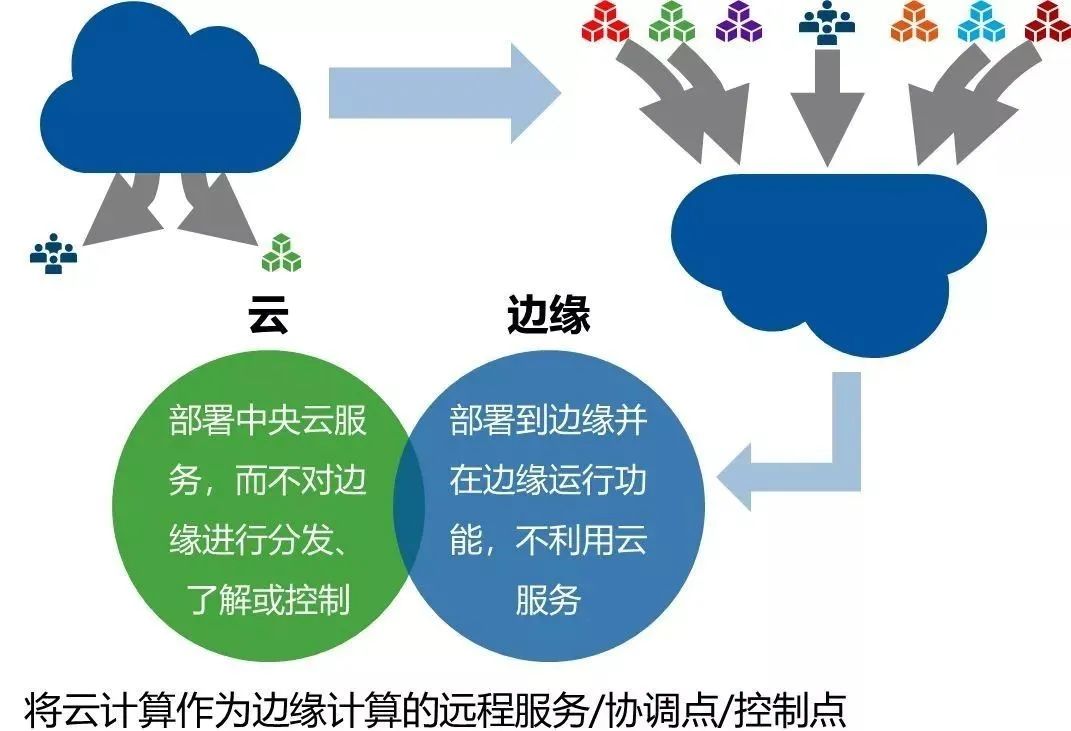
Although cloud services have become the mainstream choice, edge computing remains the best option for many application scenarios. Gartner believes that cloud computing and edge computing will closely integrate and develop in parallel.
When using public cloud services, network conditions must be considered. On one hand, certain special industries or environments make it inconvenient to access the internet or guarantee network conditions, with extreme examples such as ocean-going vessels; on the other hand, processing a large amount of data locally, rather than uploading it to the public cloud, can significantly reduce latency and network transmission costs. For instance, edge computing, a “good friend” of 5G, was typically applied in the high-speed ETC transformation project that was popular in 2019.Therefore, private deployment and hybrid clouds remain practical requirements for many customers. One major challenge of private deployment is the relatively high threshold—the purchase price of a multi-core server is obviously not comparable to the monthly rental price of a one or two-core cloud host. To achieve basic high availability, traditional methods require two servers paired with an entry-level SAN storage and corresponding switches, which multiplies procurement, deployment, management, and operational costs. Some vendors offer integrated systems for overall delivery, effectively exchanging higher procurement costs for simplified deployment and management.So, is there a solution that combines “ease of use” with “reliable high availability”?
To address this demand, ZStack launched the “ZStack Mini” edge computing integrated machine in 2019. Its appearance is comparable to a standard 2U server, but in fact, the chassis houses two dual-socket servers (the so-called “twin stars”), which are redundant to each other and equipped with a lightweight ZStack cloud engine, inheriting the advantages of ZStack’s 4S architecture:Simple (simplicity), Strong (robustness), Scalable (elasticity), Smart (intelligence). Simplicity is prioritized, while robustness mainly refers to high availability, cleverly combining traditional RAID technology and virtual machine migration technology to achieve high availability in extremely simple scenarios, which will be detailed in the next article. This article mainly focuses on the simple, elastic, and intelligent experience that can rival public clouds.
Minimal Architecture Design Reduces Acceptance Threshold

Whether deploying a large number of edge sites or IT applications for small and medium enterprises, procurement and operational costs are always a key focus, with adequacy and ease of use often being the primary demands.ZStack Mini starts from these user demands, adopting a minimal 2U2 node design, which integrates two half-width dual-socket server nodes within a single 2U industrial standard chassis, combined with a lightweight ZStack cloud engine, achieving high availability within a single 2U device. This ensures that in the event of any hardware failure, there will be no data loss or prolonged business interruption (this will be analyzed in detail in the next article). At the same time, in the case of the minimum deployment of 2 nodes, no additional switches are required; the two nodes are connected point-to-point using two dual-port network cards and fiber cables, ensuring the bandwidth required for data synchronization while being redundant to each other.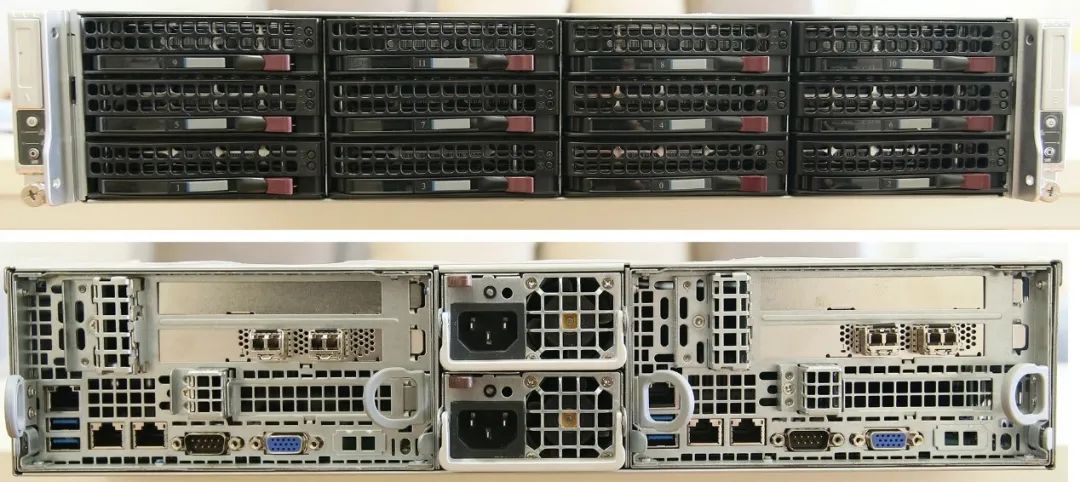
Caption: The ZStack Mini physical device in the E7 Research Lab (E7ResearchLab), with the front of the Mini shown above, which does not look significantly different from mainstream 2U rack servers, except for the power buttons on both ends; the back of the Mini shows two independent server nodes, each equipped with a dual-port 10G network card, connected point-to-point via fiber cables for data synchronization and mutual backup; the two nodes are powered by two redundant power modules.
In other words, ZStack Mini not only looks like a 2U server but also operates as simply as a 2U server—indeed, even simpler—because it comes pre-installed with a lightweight ZStack cloud engine, ready to use right out of the box (just connect the power and network). At the same time, it is indeed composed of two servers, providing double (or even higher) redundancy, ensuring high availability of the system.
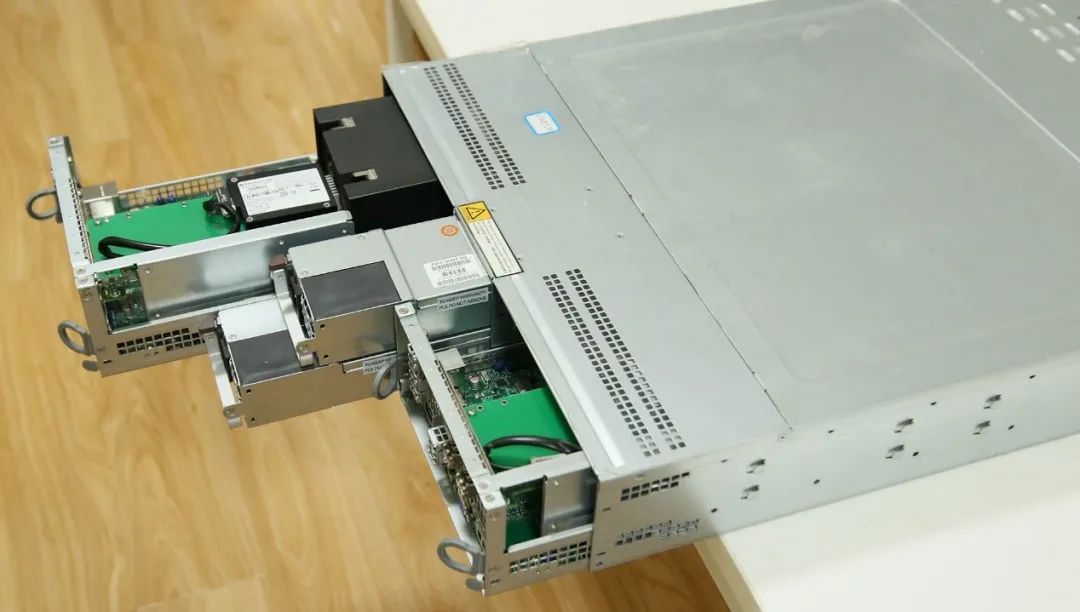
Caption: Extracting the two nodes and power modules of ZStack Mini reveals an independent component design. The two server nodes are housed within a single 2U chassis, forming a “mini” system, or a complete solution; virtualization technology is used to host different applications, achieving application integration, and the 2-node design ensures high availability.
ZStack Mini supports clustering with 2 to 20 nodes. When deploying with the minimum of 2 nodes (i.e., one ZStack Mini), the two nodes are directly connected point-to-point using 10G fiber cables, eliminating the need for an additional 10G switch, minimizing initial cost investment.In other words, in the simplest case, only one 2U rack space is needed, and it can be managed like a 2U server.In addition to the streamlined hardware architecture, ZStack Mini also fully adheres to the adequacy principle in configuration choices,further lowering the acceptance threshold for users. For example, in terms of data storage, ZStack Mini uses large-capacity 3.5-inch hard drives (HDD). The entire 2U chassis is equipped with 12 disks, with 6 disks per node, of which 2 are mirrored for the operating system and other system software; the remaining 4 are configured in RAID 5 for actual data storage, balancing availability and utilization. The total of 4 system disks across the two nodes can choose smaller capacity disks, while the other 8 can be flexibly selected based on actual needs.
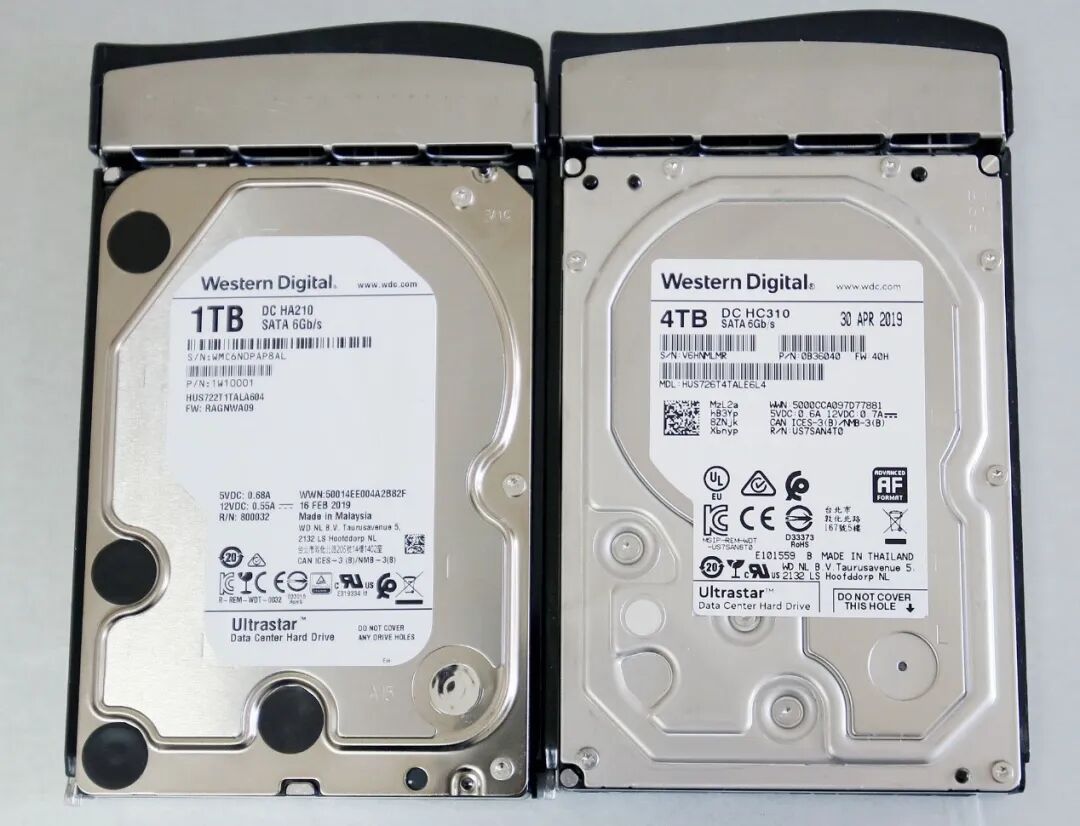
Caption: The ZStack Mini we tested is equipped with two different capacity disks, with a 1TB disk for the operating system and a larger 4TB disk for user data storage.
3.5-inch hard drives have sufficient capacity and lower cost per GB. For edge sites or small and medium enterprises, unless for special applications, they can generally meet performance requirements.Correspondingly, the two (server) nodes of ZStack Mini are equipped with 10G network cards for data networks, while the external business network uses the integrated onboard Gigabit Ethernet port on the server motherboard, allowing direct integration into the existing enterprise environment. Even for new sites, the cost of Gigabit Ethernet switches is relatively low.At the same time, the business network and management network are combined, yet can achieve out-of-band management, which reduces the required hardware quantity from an architectural design perspective while ensuring security.Do not overlook network costs!!!Even for public clouds, increasing the network configuration and public bandwidth of cloud hosts can be quite expensive.ZStack Mini effectively reduces users’ procurement costs through its minimal hardware architecture design, which is a visible “tangible” cost. In addition, ZStack Mini also helps users reduce deployment, management, and operational costs through software design and automation.
Automated Installation Configuration Ready in 1 Hour

ZStack Mini uses a lightweight ZStack cloud engine, which includes a customized and optimized operating system that not only has essential virtualization management functions such as virtual machine creation and resource allocation but also monitors server hardware and resource usage.The operating system is pre-installed in the nodes of ZStack Mini at the factory, and can also be installed or upgraded separately via USB or BMC. Before use, ZStack Mini can be pre-configured through a web management interface, and we reproduced this process in a video:
During pre-configuration, only the management IP and gateway information set through BMC need to be filled in for automated configuration, which takes about 5 minutes (during the waiting time, we accelerated the playback speed to 30 times, so the entire video is about 48 seconds).
After the environmental pre-configuration, the next step is to initialize ZStack Mini, and we will again use a short video to showcase our initialization process:
Initialization configuration still only requires filling in some necessary network information, such as the IP segment, gateway, and DNS information used for creating virtual machines. (The entire process takes about 6 minutes, and we accelerated the playback speed to 30 times, making the video about 1 minute long).
From these two videos, it can be seen that whether in pre-configuration or initialization configuration, only network-related information (again, network! This is the era of networks) such as management IP address and business IP range needs to be filled in for one-click automated installation, which is very easy to understand. Other processes, such as storage configuration, are silently installed in the background. These automated selections help simplify the installation process and reduce the complexity of user understanding.After all, most small and medium enterprise users do not need to focus on specific IT configurations and operational technologies, and ZStack tries to resolve these details from the user’s perspective, which is a thoughtful “original intention” worth appreciating.In the IT operations process of enterprises, the time spent on deployment and system initialization actually accounts for a very small portion, as a one-time deployment can support several years. More time is spent on management and operations, and how to simplify management and operations is both a focus and a challenge in product design. Next, E7Research will summarize ZStack’s design in this regard based on its experience with the ZStack Mini product.
Fully Graphical + Automated Simplified Management and Operations

ZStack Mini inherits ZStack’s excellent design philosophy, adopting a fully graphical management interface design while fully considering the operational challenges faced by small and micro enterprises and edge sites, greatly simplifying management processes, with many intermediate processes automated, making guided operations easy to grasp.
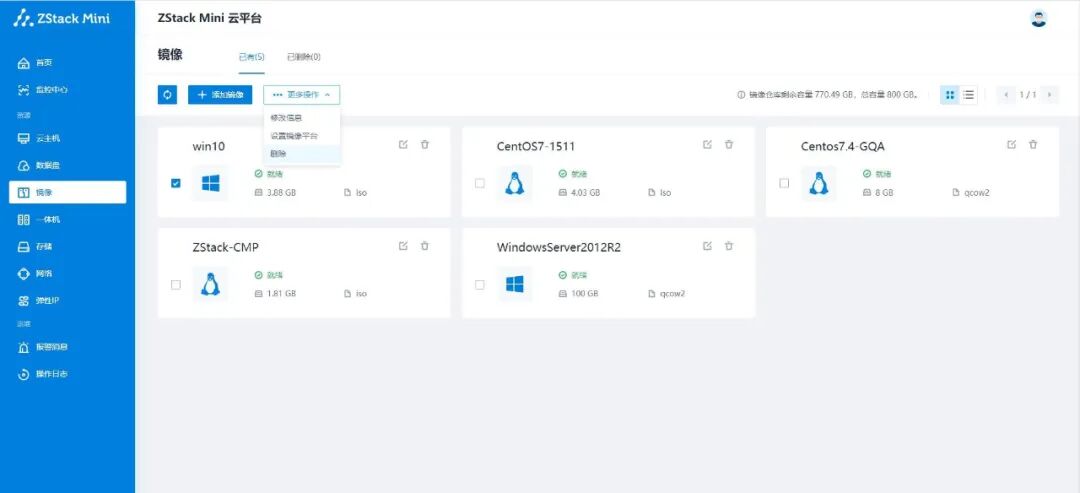
Caption: By clicking the “Add Image” button, users can add custom images, flexibly selecting the operating system required for cloud hosts (virtual machines) based on previous application environments or preferences.
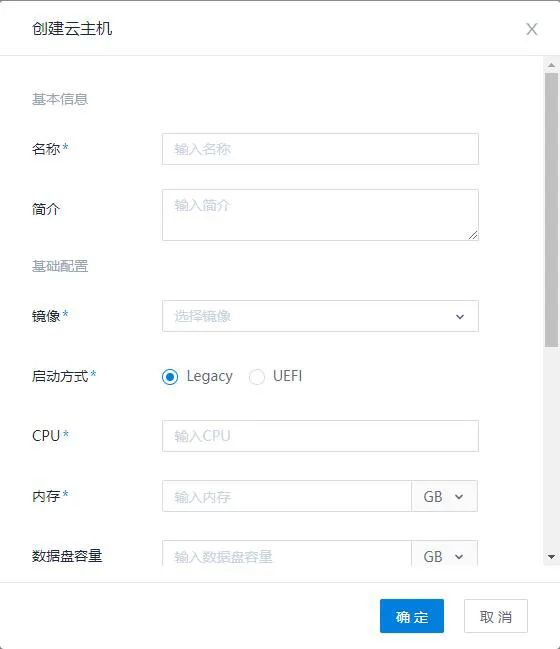
Caption: To create a cloud host, click the button, then fill in the necessary virtual machine name and configuration to create a new virtual machine, completing the entire process on a single interface, with all other processes executed automatically in the background.

Caption: Creating a data disk is similar to creating a cloud host; just fill in the necessary information on a single interface to complete the creation, reducing many intermediate process steps.
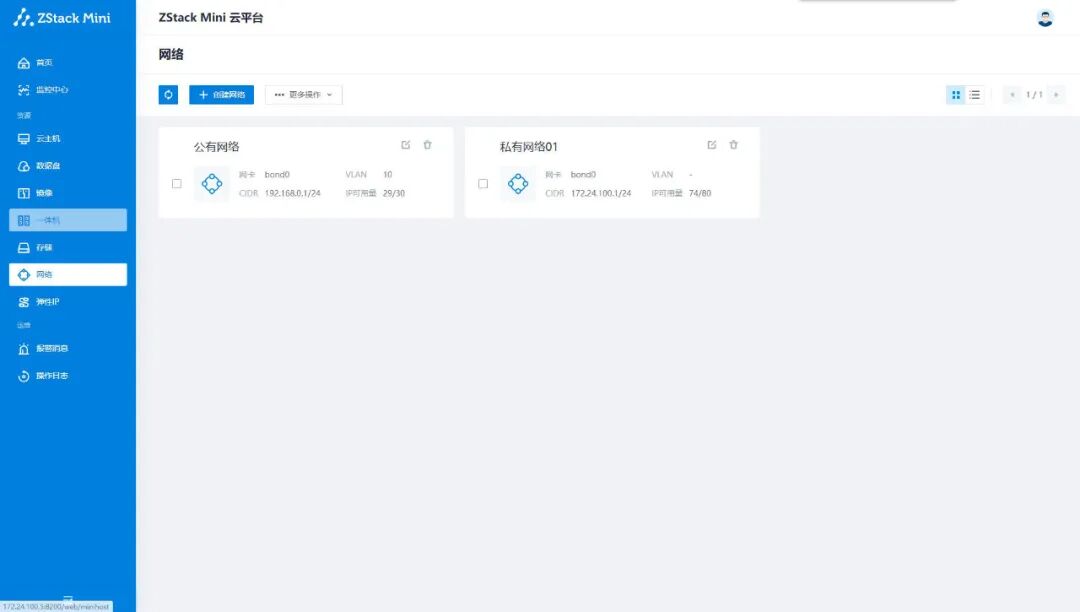
Caption: In cloud environments, due to application integration, networks are often prone to errors. ZStack Mini provides some enterprise-level network functions, such as creating multiple isolated networks, which can simplify network management and reduce the likelihood of errors.
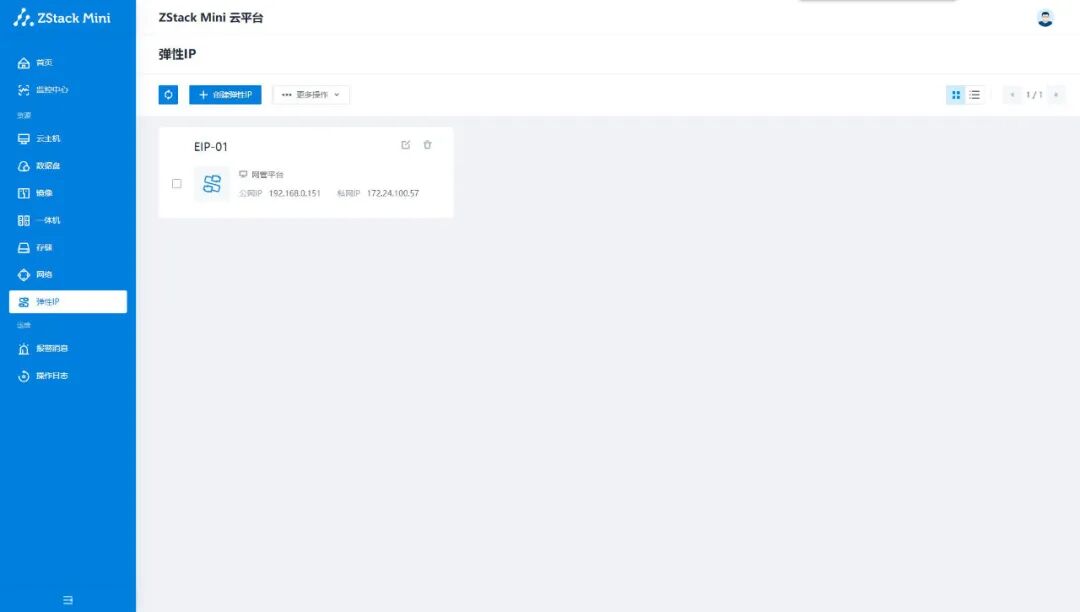
Caption: Typically, some application servers that do not frequently access the internet are deployed in private networks, but for certain reasons need to access the internet for upgrades, ZStack provides an “elastic IP” method, creating an elastic IP that can be mapped to the cloud host needing internet access, allowing connectivity; when not needed, it can be disconnected. This provides flexibility while enhancing the security of cloud hosts.
With just a few button clicks, users can complete the creation of virtual machines, data disks, and more. This not only simplifies complexity but also effectively reduces the likelihood of operational errors. The simplified process also aids users across various industries in using and managing the system.In terms of management and monitoring, ZStack has also adopted the trendy concept of “digital twin,” mapping the status information of each component of the physical machine to the digital world, graphically displaying it to guide operational management and reduce the likelihood of errors.
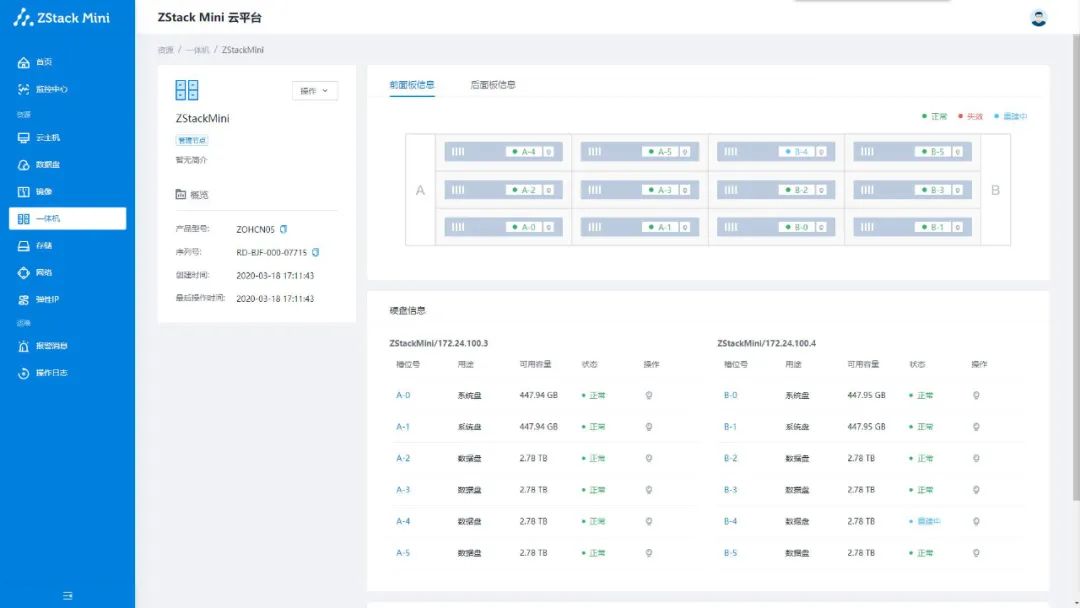
Caption: The component monitoring status on the front panel of ZStack Mini’s “integrated machine” not only reflects the location and detailed status information of each component of the server in a digital manner. For example, in the image above, the hard drive numbered “B-4” on the second node is in a rebuilding state, visually displaying the slot position of each hard drive with different colored dots indicating their status.
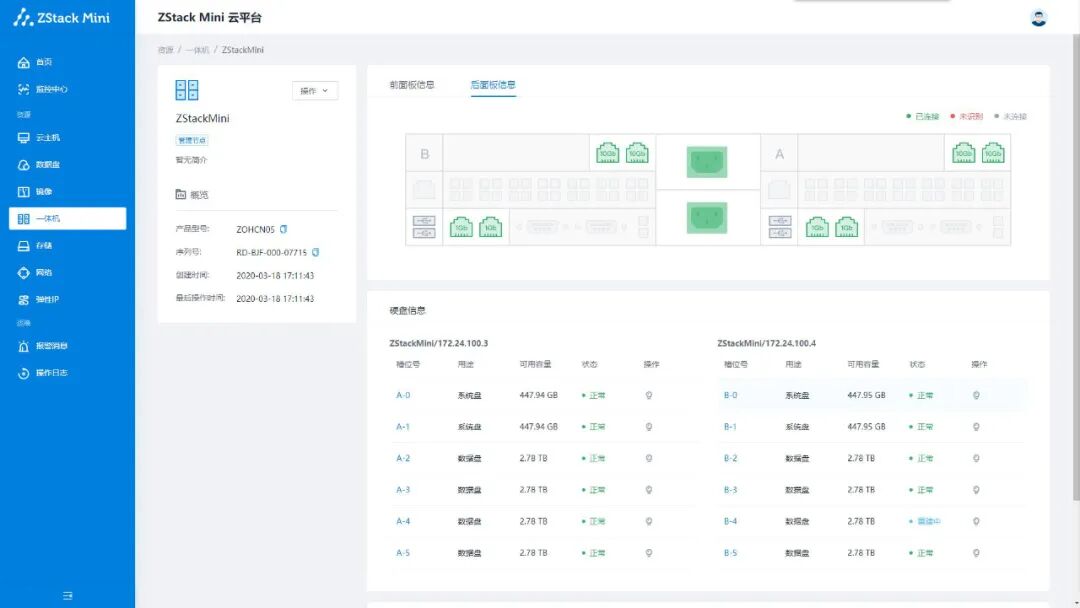
Caption: The component monitoring status on the back panel of ZStack Mini’s “integrated machine” mainly displays information about network ports and power, with green indicating connectivity.
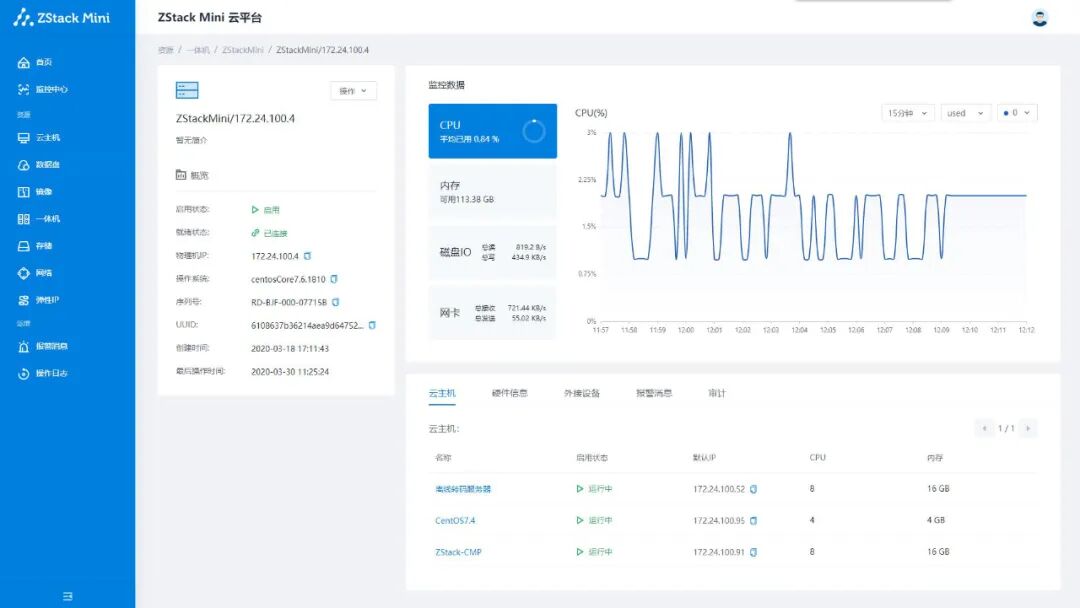
Caption: On the “physical machine” monitoring page, users can see the current resource usage of physical machine nodes, allowing them to manually adjust resource distribution based on usage.
In areas requiring manual creation, ZStack Mini simplifies processes through design and automation to facilitate easier resource usage for users, reducing the likelihood of errors during operations.In terms of health monitoring and information display, graphical methods are used as much as possible to facilitate user understanding and avoid operational errors during maintenance. These designs reflect that ZStack fully considered user needs from the very beginning of product design, integrating principles of simplification, convenience, and intelligence to better assist users in using and managing ZStack Mini.
In the above introduction, the elasticity and intelligence of ZStack Mini are presented to varying degrees through simplicity,so how can simplicity and high availability coexist? How are intelligence and elasticity reflected in this? The next article will analyze this based on our actual experience.

The E-Enterprise Research Institute focuses on research into new technologies such as cloud computing, AI, and data centers, analyzing new products, providing consulting services for manufacturers, and offering user consultation services to lower the cost of adopting new technologies and solutions.
The E-Enterprise Academy is an online education and technology knowledge sharing platform aimed at the B2B enterprise market, focusing on IT knowledge and learning sharing related to the latest hardware and software solutions in data centers and cloud computing, cultivating practical talents for enterprises, and creating a complete IT learning application from talent cultivation to technology output.Please scan the “E-Enterprise Academy Assistant” QR code to obtain information on premium courses and participate in interactions.
